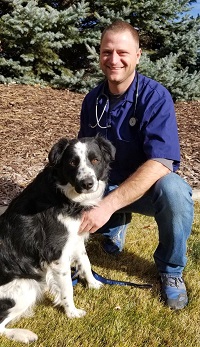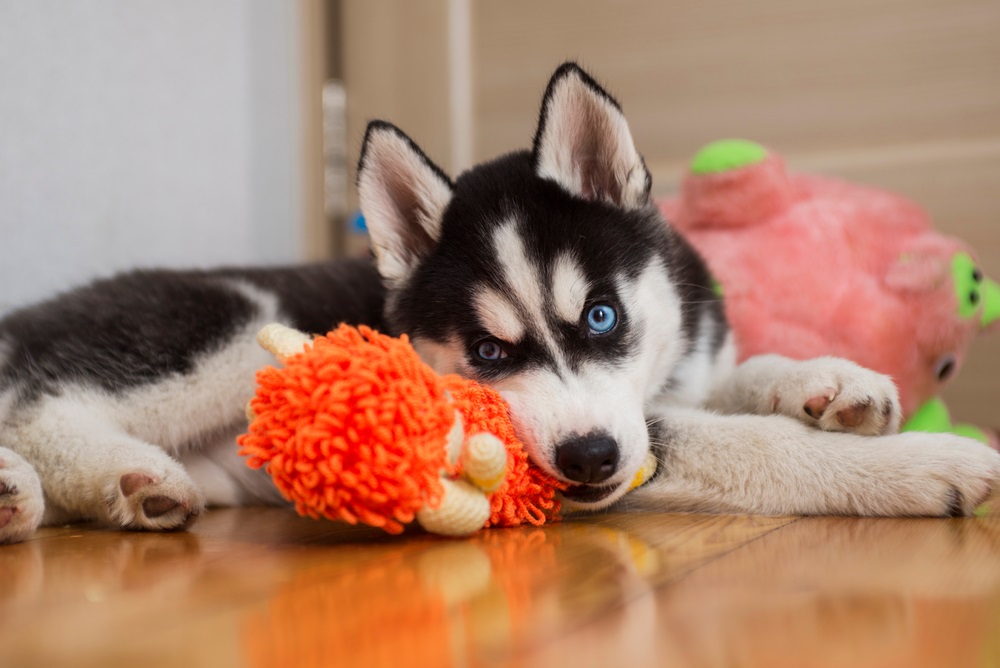If there’s one feature we associate with most husky breeds, it’s their beautiful eyes. Some have brown eyes, some have blue eyes, and some have different colored eyes, the eyes of a husky are immediately recognizable for their unique eye color and appealing almond shape.1
That said, Siberian huskies are susceptible to a few eye conditions that can cause discomfort and, in some cases, lead to partial vision loss and complete blindness.
The good news? Regularly checking your four-legged friend for early signs of common husky eye problems is an effective preventative measure that may spare your husky puppy’s pupils from serious degeneration. By knowing the signs of the three common issues below, you’ll be on the path to keeping your Siberian husky’s eyes stunning, striking, and sighted.
Know the Signs of Corneal Dystrophy
Corneal dystrophy is a fairly common husky eye problem. Signaled by a opaque or cloudy eyes and cataract-like appearance in your dog’s eyes, the disease refers to three distinct conditions. These conditions can affect huskies of all eye colors and sex, although female huskies are at increased risk.2
Each type of corneal dystrophy is a genetic disorder passed down through generations of huskies. The three types of corneal dystrophies are:
Endothelial Corneal Dystrophy
Corneal dystrophies in this category is an eye problemmost prevalent among small breed dogs like dachshunds and Chihuahuas, but your Siberian husky is not exempt. Checking for characteristic signs is imperative to safeguarding their eyes.
Because “endothelial” refers to the innermost corneal layer, the condition can be hard to detect in the initial stages. If you notice a fluid-like build-up known as edema beginning along the outer edges of the cornea, you should consult with your vet to stall progression and prevent late-stage symptoms, which can include:3
- Corneal ulcers
- Blindness
Epithelial Corneal Dystrophy
Epithelial dystrophies is an eye disease that affects the outermost layer of the cornea.4 The telltale sign—and in many cases, the only sign—of epithelial dystrophy is cloudy, gray or white patches known as corneal opacity.
Although for some older huskies, opaque patches on the cornea are the only symptom of epithelial corneal dystrophies, keeping a close eye on the condition is a necessary step to preserve your husky’s ocular health.
Corneal dystrophies are rarely treatable in the early stages, but as the condition progresses, your husky puppy’s medical practitioner may recommend a consultation with a canine ophthalmologist. These experts can determine your pup’s risk of developing corneal lesions, which can cause complications. Affected Siberian huskies will experience :
- Corneal pain
- Squinting
- Light sensitivity
Stromal Corneal Dystrophy
Stromal dystrophies develop on the middle layer of the cornea and generally begin as gray, white, or silver opacity. This eye condition usually appears in the following forms:5
- As patches on the cornea’s center
- As a ring around the cornea’s outer edge
- As an opacity of the entire cornea
Stromal dystrophies are a common husky eye problem that’s also prevalent among an array of other dog breeds, like the border collie and most breeds of spaniels, including the cocker spaniel, but most dogs evade progressive symptoms of stromal dystrophies. Nevertheless, you should still talk to your veterinarian if you notice any opacity to give you a head start on treatment in the rare case that the condition causes corneal pain, inflammation, or both.
If your pup or older husky suffers discomfort caused by corneal dystrophy, Vetericyn’s Antimicrobial Eye Gel for Pets, available from Amazon, Chewy, and PetCo, can help moisten and lubricate eyes.
Check for Juvenile Cataracts
Although non-hereditary cataracts are a frequent eye condition of older huskies, huskies as young as three months of age are uniquely prone to developing a variety known as juvenile or hereditary cataracts. This is the most widespread condition among all husky eye problems.6
If your canine companion is still a pup, be on the lookout for cataracts that grow on the lens of either or both eyes. In some cases, juvenile cataracts remain small, fairly innocuous, and may not require treatment.
That said, if opacity from cataracts develops, your veterinarian will likely want to perform regular examinations to determine their growth, as larger cataracts can prevent light from entering the eye, resulting in partial or full vision loss. Fortunately, a simple surgery is available to remove large cataracts and restore your husky’s eyesight.7
Look for Symptoms of Progressive Retinal Atrophy
Progressive retinal atrophy (PRA) is an eye disease refers to the incremental deterioration of special cells in the retina called photoreceptors.8 These cells are responsible for converting light rays into electrical signals before they’re processed by the brain.
There are two types of photoreceptor cells:
- Rod cells, which detect movement in low light conditions
- Cone cells, which scan the environment for color
Inherited forms of PRA, known as retinal dysplasia, are characterized by early onset in huskies as young as only two or three months.9 Dogs between the ages of three and nine can develop adult-onset PRA. Signs of cell deterioration include:
- Decreased night vision
- Enhanced light reflection in the eyes
- Dilated pupils
Although there is no currently no treatment for PRA, underlying contributors can be treated and may reduce your husky’s risk of blindness that can be caused by cell deterioration.
Keep an Eye on Your Husky’s Ocular Health with Vetericyn
Eye care is essential to protecting your husky’s sight and preventing other common husky health problems. Monitoring your dog’s eyes for signs of husky eye problems is an important first step of proper pet health, but when eye ailments develop, Vetericyn is here to help.
From antimicrobial eye gels that moisten and lubricate eyes to our Antimicrobial Eye Wash for flushing, cleaning, and removing foreign irritants, Vetericyn offers a safe way to care for your husky’s lookers at home.
 Reviewed by Dan Richardson, Veterinarian
Reviewed by Dan Richardson, Veterinarian
Dan Richardson has been a practicing veterinarian for over 10 years. He specializes in surgery and orthopedics. Dan is originally from rural western Nevada and attended the University of Idaho for undergraduate study and Oregon State University for Veterinary School. The Richardson Family enjoys camping and spending time on the water fishing, paddle boarding, or digging their feet in the sand somewhere warm.
Sources:
- Spirit Dog Training. 22 Types of Huskies. https://spiritdogtraining.com/breeds/types-of-huskies/
- Husky Rescue. Eye Color Variations and Common Diseases. https://www.huskyrescue.org.za/husky-eyes/
- VCA Animal Hospitals. Corneal Dystrophy in Dogs. https://vcahospitals.com/know-your-pet/corneal-dystrophy-in-dogs
- The Siberian Husky Club of America. Genetic Defects of the Eye. https://www.shca.org/eye-testing
- PetMD. Juvenile Cataracts. https://www.petmd.com/blogs/purelypuppy/lradosta/2012/aug/juvenile_cataracts_puppy-26754
- VCA Hospitals. Progressive Retinal Atrophy in Dogs. https://vcahospitals.com/know-your-pet/progressive-retinal-atrophy-in-dogs
